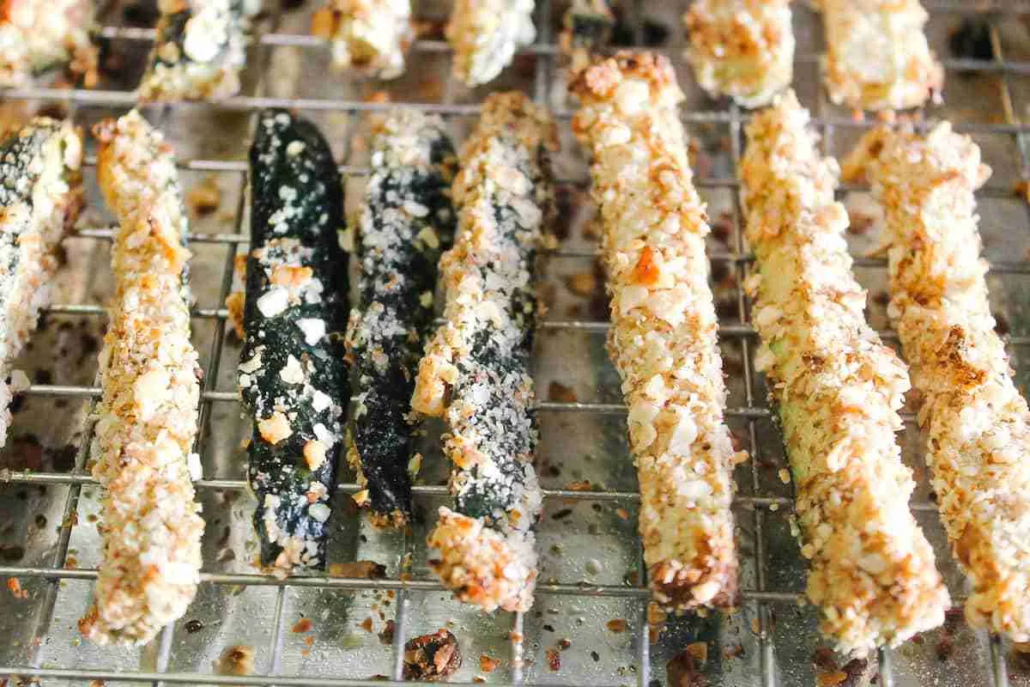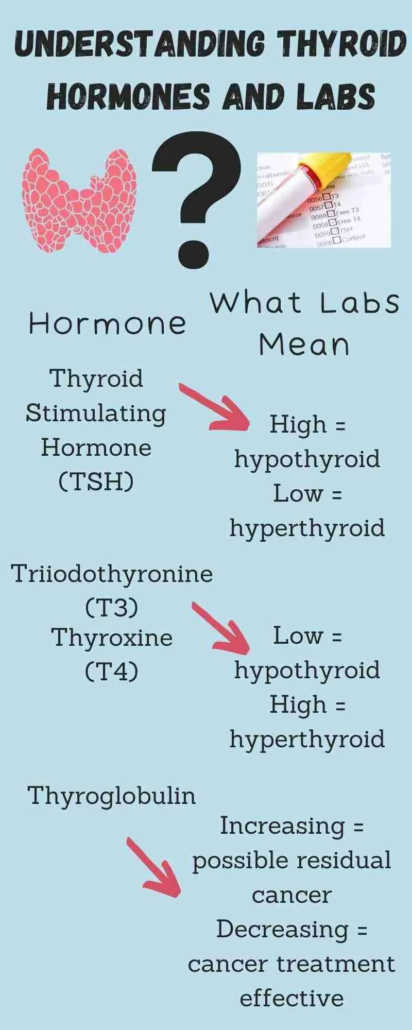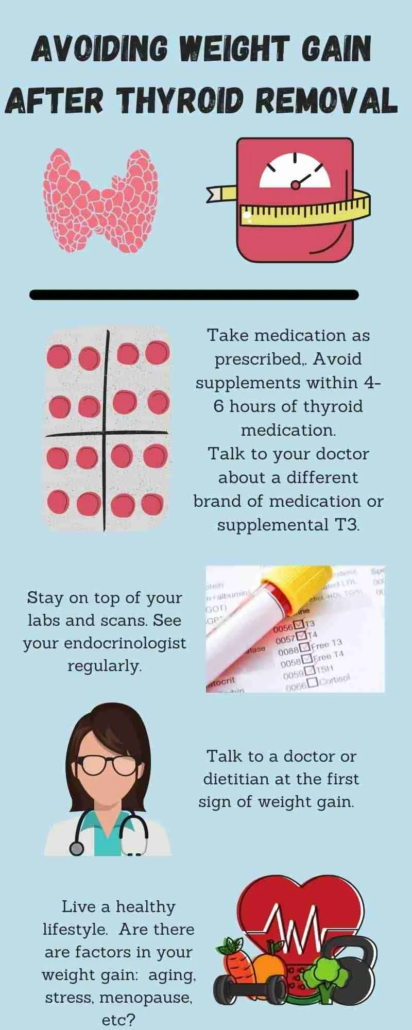- plant based milk (Elmhurst is a great LID friendly option)
- nutritional yeast
- matzo crackers or breadcrumbs (Kikkoman for LID)
- walnuts
- olive oil
- garlic
- salt (non iodized for LID)
- Black pepper
Special equipment (optional):
- food processor
- wire baking rack
- air fryer
How to make
It only takes a few simple steps to make vegan zucchini fries:
- Cut zucchini into fry shape. Don’t go too thin, as it will be harder to get the crumbs to stick.
- Chop walnuts (and matzo if using) in a food processor.
- Add nutritional yeast, breadcrumbs (if not using matzo), salt, and pepper. Pulse until all is the consistency of bread crumbs.
- Heat the olive oil with the garlic to infuse flavor, then toast crumb mixture in olive oil.
- Dip zucchini into “milk”, then into breadcrumb mixture. Press down to make sure crumbs stick.
- Bake on wire rack. The wire rack promotes crispiness all the way around.

Variations of Zucchini Fries
- Air fryer vegan zucchini fries: If you want to use an air fryer, you will fry at 400 degrees F for 10 minutes total. Spray the fries with cooking spray before putting in the fryer. After 5 minutes, pull out the basket, shake the fries, and spray with cooking spray again. Cook for another 5 minutes, or your desired level of doneness.
- Nut free: You could skip the walnuts in the crumb mixture if you are avoiding tree nuts.
- Zucchini fries without breadcrumbs: You could use flour flavored with nutritional yeast, garlic powder, salt, and pepper in place of the breadcrumb mixture. The coating will be less of your typical bread coating but is still yummy.
- Gluten free zucchini fries: Substitute gluten free crackers for the matzo crackers or breadcrumbs. Or just flavor almond flour with nutrition yeast, garlic powder, salt, and pepper.
- You could mix up the seasonings for any variation you’d like: Italian seasoning, add some cayenne and cumin for zesty flavors, etc.
FAQ
Do I need to salt the zucchini first?
I feel like recipes online are 50/50 on salting the zucchini first. Salting the zucchini should draw out water from the zucchini, which is a really watery vegetable. It should make it more crisp and less soggy. In all my practicing, I did not notice a difference between the batches where I salted the zucchini and did not.
What is nutritional yeast?
Nutritional yeast is NOT the same yeast you use to bake bread. Nutritional yeast is flakes of inactive yeast. While it starts as the same species as baking yeast, it is fermented, has nutrients added, and then is dried to inactivate the yeast. It is a great source of protein and B vitamins, including B12. It is a great substitute for cheese when avoiding dairy.
Is the low iodine diet vegan?
You do not have to follow a vegan diet while on the low iodine diet. However, vegan recipes are often a good resource as they avoid eggs and dairy. Just be cautious of sea salt and other high iodine foods, such as most commercial plant based milks.
For more on the low iodine diet, check out my Low Iodine Diet Basics.

Tips for Reheating
Like most fried foods, zucchini fries do not make the best leftovers. You can reheat them in the oven for 5-10 minutes until warm. Or reheat in the air fryer. Putting them in the microwave will lead to a soggy mess.
Crispy Vegan Zucchini Fries
Equipment
- food processor
- wire baking rack optional
Ingredients
- 2 medium zucchini
- cooking spray
- ¾ cup plant-based milk almond, oat, not soy
- ½ tsp salt non iodized for LID, divided
- ½ tsp ground black pepper divided
- 1 cup walnuts unsalted
- 1 sheet matzo cracker or ½ cup breadcrumbs
- ¼ cup nutritional yeast
- 1 clove garlic peeled
- ⅓ cup olive oil
Instructions
- Cut the zucchini into sticks (fry shapes), about 3 inches long and ½ inch thick.
- Preheat oven to 425 degrees F. Line a baking sheet with aluminum foil. Place wire baking sheets on top and spray with non stick cooking spray.
- Combine milk, ¼ tsp salt, and ¼ tsp pepper in shallow bowl.
- In a food processor, chop walnuts and matzo (if using) until small pieces. Add remaining salt and pepper, nutritional yeast, and breadcrumbs (if using). Process until all is the consistency of breadcrumbs.
- Heat olive oil in a small fry pan over medium-low heat. When warm, add whole clove of garlic. Cook until fragrant. Remove garlic from oil.
- Add breadcrumb/nut mixture to oil. Toast until golden brown. Remove from heat, and place in a shallow dish.
- Dip zucchini fries in milk, then in breadcrumb mixture. Press gently to ensure crumbs stick. Place carefully on prepared wire rack, ensuring fries do not touch.
- Bake at 425 for 20-30 minutes, until crumbs are crispy and golden brown.
Notes
Nutrition
Let me know how you enjoy your crispy vegan zucchini fries!
These vegan zucchini fries are a healthy vegetable all dressed up in its crispy finger food finest. Crispy while being vegan and keto friendly, they will be a hit with everyone!
As an Amazon Associate, I earn from qualifying purchases.
What you’ll need to make vegan zucchini fries
Zucchini fries normally have eggs and cheese to make, but we are making these without those to be vegan and LID friendly.
Ingredients:
- plant based milk (Elmhurst is a great LID friendly option)
- nutritional yeast
- matzo crackers or breadcrumbs (Kikkoman for LID)
- walnuts
- olive oil
- garlic
- salt (non iodized for LID)
- Black pepper
Special equipment (optional):
- food processor
- wire baking rack
- air fryer
How to make
It only takes a few simple steps to make vegan zucchini fries:
- Cut zucchini into fry shape. Don’t go too thin, as it will be harder to get the crumbs to stick.
- Chop walnuts (and matzo if using) in a food processor.
- Add nutritional yeast, breadcrumbs (if not using matzo), salt, and pepper. Pulse until all is the consistency of bread crumbs.
- Heat the olive oil with the garlic to infuse flavor, then toast crumb mixture in olive oil.
- Dip zucchini into “milk”, then into breadcrumb mixture. Press down to make sure crumbs stick.
- Bake on wire rack. The wire rack promotes crispiness all the way around.

Variations of Zucchini Fries
- Air fryer vegan zucchini fries: If you want to use an air fryer, you will fry at 400 degrees F for 10 minutes total. Spray the fries with cooking spray before putting in the fryer. After 5 minutes, pull out the basket, shake the fries, and spray with cooking spray again. Cook for another 5 minutes, or your desired level of doneness.
- Nut free: You could skip the walnuts in the crumb mixture if you are avoiding tree nuts.
- Zucchini fries without breadcrumbs: You could use flour flavored with nutritional yeast, garlic powder, salt, and pepper in place of the breadcrumb mixture. The coating will be less of your typical bread coating but is still yummy.
- Gluten free zucchini fries: Substitute gluten free crackers for the matzo crackers or breadcrumbs. Or just flavor almond flour with nutrition yeast, garlic powder, salt, and pepper.
- You could mix up the seasonings for any variation you’d like: Italian seasoning, add some cayenne and cumin for zesty flavors, etc.
FAQ
Do I need to salt the zucchini first?
I feel like recipes online are 50/50 on salting the zucchini first. Salting the zucchini should draw out water from the zucchini, which is a really watery vegetable. It should make it more crisp and less soggy. In all my practicing, I did not notice a difference between the batches where I salted the zucchini and did not.
What is nutritional yeast?
Nutritional yeast is NOT the same yeast you use to bake bread. Nutritional yeast is flakes of inactive yeast. While it starts as the same species as baking yeast, it is fermented, has nutrients added, and then is dried to inactivate the yeast. It is a great source of protein and B vitamins, including B12. It is a great substitute for cheese when avoiding dairy.
Is the low iodine diet vegan?
You do not have to follow a vegan diet while on the low iodine diet. However, vegan recipes are often a good resource as they avoid eggs and dairy. Just be cautious of sea salt and other high iodine foods, such as most commercial plant based milks.
For more on the low iodine diet, check out my Low Iodine Diet Basics.

Tips for Reheating
Like most fried foods, zucchini fries do not make the best leftovers. You can reheat them in the oven for 5-10 minutes until warm. Or reheat in the air fryer. Putting them in the microwave will lead to a soggy mess.
Crispy Vegan Zucchini Fries
Equipment
- food processor
- wire baking rack optional
Ingredients
- 2 medium zucchini
- cooking spray
- ¾ cup plant-based milk almond, oat, not soy
- ½ tsp salt non iodized for LID, divided
- ½ tsp ground black pepper divided
- 1 cup walnuts unsalted
- 1 sheet matzo cracker or ½ cup breadcrumbs
- ¼ cup nutritional yeast
- 1 clove garlic peeled
- ⅓ cup olive oil
Instructions
- Cut the zucchini into sticks (fry shapes), about 3 inches long and ½ inch thick.
- Preheat oven to 425 degrees F. Line a baking sheet with aluminum foil. Place wire baking sheets on top and spray with non stick cooking spray.
- Combine milk, ¼ tsp salt, and ¼ tsp pepper in shallow bowl.
- In a food processor, chop walnuts and matzo (if using) until small pieces. Add remaining salt and pepper, nutritional yeast, and breadcrumbs (if using). Process until all is the consistency of breadcrumbs.
- Heat olive oil in a small fry pan over medium-low heat. When warm, add whole clove of garlic. Cook until fragrant. Remove garlic from oil.
- Add breadcrumb/nut mixture to oil. Toast until golden brown. Remove from heat, and place in a shallow dish.
- Dip zucchini fries in milk, then in breadcrumb mixture. Press gently to ensure crumbs stick. Place carefully on prepared wire rack, ensuring fries do not touch.
- Bake at 425 for 20-30 minutes, until crumbs are crispy and golden brown.
Notes
Nutrition
Let me know how you enjoy your crispy vegan zucchini fries!




